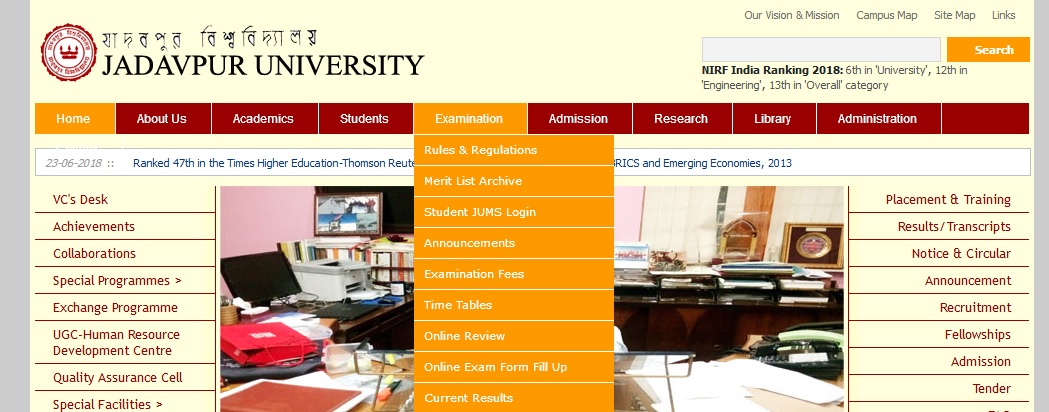Waste Treatment Engineering B.Tech Question Paper : jaduniv.edu.in
Name of the University : Jadavpur University
Department : Food Tech & Bio-Chemical Engineering
Degree : B.Tech
Subject Name : Waste Treatment Engineering
Year/Sem : II/II
Website : jaduniv.edu.in
Document Type : Model Question Paper
Download Model/Sample Question Paper : https://www.pdfquestion.in/uploads/dspace.jdvu.ac.in/6437-Waste%20Treatment%20Engineering.pdf
Jadavpur Waste Treatment Engineering Question Paper
Bachelor Of Technology (F.T.B.E.) Examination, 2011 :
( 2nd Year, 2nd Semester )
Time : Three Hours
Full Marks : 100
Use a separate Answer-Script for each Part (50 marks for each Part)
Related : Jadavpur University Chemical Engineering Fundamentals B.Tech Question Paper : www.pdfquestion.in/6435.html
Part – I
Attempt any Three questions :
All questions carry equal marks. :
1. How are the characteristics of industrial waste water expressed? What is the importance of dissolved oxygen which is present in water? How does it help for the treatment of waste water? How the dissolved oxygen level is maintained in the stream, explain with the help of oxygen Sag curve. 16
2. Answer any two : 2×8=16
i) State the function and importance of two stage anaerobic sludge digestion (High rate process) for production of Biogas.
ii) Discuss the phenomenon of discrete sitting of particles in primary treatment process.
ii) Discuss the working principle of Trickling filter which acts as attached growth biological reactor.
3. Write short notes (any two) 2×8=16
i) Facultative logoon
ii) Pure oxygen aeration process
iii) Physical methods for separation of non-bio-degradable matter from waste water.

4. Discuss the relative merits and demerits of Batch and continuous processes for treatment of waste water. How will you proceed to formulate the design criteria for a continuous biological reactor. 16
5. i) From the kinetic consideration establish the Mathematical Model for the BOD curve which is equivalent to destruction of organic matter by biological oxidation. Form the Rate equation in terms of organic matter concentration present in waste water as L, mg/l. 8
ii) The data on oxygen utilisation are given below in BOD tests of waste water. Obtain the rate constant (k) and initial organic matter concentration (LO) using the established B.O.D. equation.
Part – II
Attempt any Three questions : 3×16=48
General Proficiency –– 2
6. a) Between BOD and COD, which one usually assumes higher value for a food plant. Justify your answer.
b) Name two food plants having high value of BOD mentioning the approx. range of the values.
c) What is the prescribed safe disposal limit of BOD? d) Determine the ThOD of an amino acid assuming CO2 and Nitrate as end products.
e) Why do you examine 5-day BOD usually? 3+3+1+6+3
7. a) Draw a standard flow chart for waste water treatment operation.
b) With neat sketch show and explain the settling characteristics of particles at different zone during sedimentation operation with a sample of waste
c) Analyze an interface settling curve.
d) What is the basic difference between primary clarification and secondary clarification? 4+7+3+2
8. a) Calculate BOD2 of one mole of microbial cell.
b) Mention the main operations and processes done to reduce water and organic content of sludge.
c) An waste treatment plant is required to digest a sludge in such a way that the moisture content is reduced to 90% from the initial value of 95%. The inflow of sludge initially contains 60% volatile matter in the solid portion and during digestion only 60% of the volatile matter is destroyed. The volatile matter has a specific gravity of 2.5 and fixed solid has a value of 1.0. Calculate the volume of sludge beforeand after digestion if the inflow contains 1000 lb dry solid. 3+2+11
Syllabus
Waste Treatment Engineering :
1. Environment and energy of nature.
2. Water for food and biochemical industries.
3. Stream pollution and measurement.
4. a) Physical treatment. b) Chemical treatment. c) Drying and incineration.
5. Industrial waste treatment : a) Vacuum treatment b) Sludge lagooning. c) Drying and incineration.
6. Treatment and disposal of sludge solids a) Vacuum treatment b) Sludge lagooning c) Drying and incineration.
7. Microbial flocculation and sedimentation, Design of biofilters and bioclarifiers. Ion exchange in biological fluids.
8. Biogas.